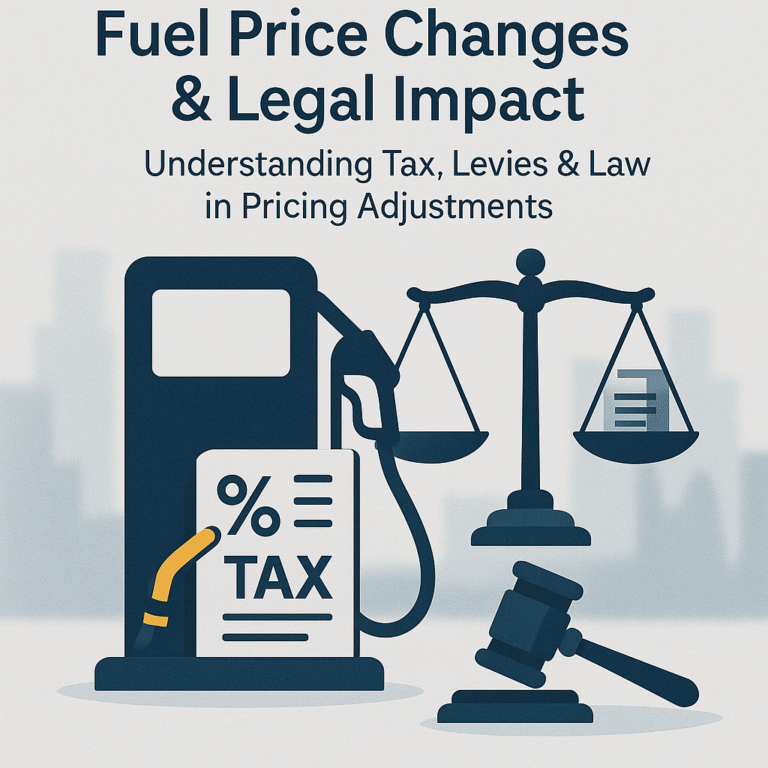In contract law, fair risk allocation depends on differentiating between gasoline price adjustments triggering a “change in law” provision and those not so as stated. Usually regarded as a “change in law,” a gasoline price increase resulting from a new tax, levy, government fee, or elimination of a subsidy could possibly entitles the contractor to a price adjustment under the contract. On the other hand, price adjustments motivated by regular market fluctuations, such as supply and demand dynamics or routine reviews—do not count as a “change in law” and are typically not reimbursed unless the contract specifies a specific price adjustment or escalation formula. < For example, Aramco yearly changes fuel prices in Saudi Arabia using a clear, consistent system applied starting in 2022. Not by calling for “change in law,” but rather by means of formula-based price adjustment clauses, these predictable changes are anticipated and controlled. Thus, claims on a “change in law” provision only justify unanticipated, exceptional changes resulting from new legislative requirements—not typical or market-driven fluctuations.
Like Clause 13.7 in the FIDIC contract, this principle was tested in the historic case South East Asia Marine Engineering and Constructions Ltd. (SEAMEC Lt.) vs Oil India Limited (2020), where the Supreme Court of India clarified the scope of Clause 23, equivalent to Clause 13.7, concerning High-Speed Diesel (HSD) price increases.
Background of the SEAMEC vs Oil India Argument 🏆
Effective from 5 June 1996 to 4 October 2000, Oil India Limited contracted SEAMEC for well drilling and auxiliary activities in Assam, in 1995. Government circulars caused HSD prices—necessary for drilling—to rise during the period of the contract. Arguing that these price increases amounted to a “change in law,” SEAMEC claimed reimbursement under Clause 23—referred to as Clause 13.7 in the FIDIC context—by Oil India denied the allegation, claiming the rises were not legislative actions. Under Clause 23 the Arbitral Tribunal decided that government circulars had the “force of law,” awarding SEAMEC Rs. 98,89,564—later reduced to Rs. 1,32,32,126.36. The award was revoked by the Gauhati High Court, which led SEAMEC to petition to the Supreme Court ([2020] AIR SC 2323, paras 2–6).
Clause 23: Legal Change Provision 👀
“SUBSEQUENTLY ENACTIVE LAWS: Subsequent to the date of price of bid opening if there is a change in or enactment of any law or interpretation of existing law, which results in additional cost/reduction in cost to Contractor on account of the operation under the Contract, the Company/Contractor shall reimburse/pay Contractor/Company for such additional/reduced cost actually incurred,” Clause 23 (analogous to Clause 13.7 in the FIDIC Conditions of Contract) reads. (Parally 16)
This clause reflects FIDIC Clause 13.7, which permits changes in legislation or laws influencing contract costs—that is, new taxes, levies, or subsidy reductions. The extent of the Supreme Court’s ruling depends on whether the cost shift comes from a genuine legal enactment or reinterpretation—not from ordinary administrative acts or market forces.
Lead by Justice N.V. Ramana, the Supreme Court rejected SEAMEC’s appeal on May 11, 2020, therefore maintaining the Gauhati High Court’s ruling to reject the arbitral verdict. The Court’s examination concentrated on whether, under Clause 23, HSD pricing hikes via government circulars constituted as a “change in law.”
Important Court Results
The Erroneous view of the Arbitral Tribunal: The Tribunal adopted a liberal view, equating government circulars altering HSD rates to a “change in law” and deemed Clause 23 a “Habendum Clause,” needing wide construction. The Court decided this reading to be negative since it ignored the fixed-rate nature of the contract and SEAMEC’s responsibility to provide fuel at its expense (paras 17, 31–32).
The contract, obtained via a competitive tender, was based on fixed rates and SEAMEC assumed the risk of price changes. Clause 23 lacking explicit language to cover HSD pricing fluctuations, demanded clear language. The Court underlined that without special contractual clauses, contractors have to consider expected market risks (para 30).
3. Judicial Construction of Clause 23: The Court decided that Clause 23, like FIDIC Clause 13.7, only covers cost adjustments resulting from new legislative enactments or reinterpretations of existing laws, including new taxes, levies, or subsidy reductions. Lack of statutory power, HSD price increases via executive circulars, did not constitute a “change in law.” The Tribunal’s reading compromised the intent of the contract and the goal of the clause (paras 17, 28–29).
Differentiating Legal from Non-Legal Changes: The Court agreed that only new legal rules—such as taxes, levies, fees, or subsidy removals—cause a “change in law.” Like market-driven changes, routine administrative adjustments—like HSD price increases—are handled under escalation clauses. This reflects policies such as formula-based annual modifications made by Saudi Aramco, which are predictable and legally covered (para 30, changed guidance).
Five: Judicial Review Refer to Section 34: The Court underlined that Section 34 of the Arbitration and Conciliation Act, 1996 allows perversity or public policy violations to be grounds for setting aside arbitral rulings. Rereading the contract, the Tribunal’s interpretation was not a reasonable one since it justified judicial intervention (paras 11–15).
Results
Declaring that the Tribunal’s reading of Clause 23 was irrational, the Supreme Court decided that HSD price hikes did not represent a “change in law.” The appeal of SEAMEC was turned down; the arbitral ruling was thrown out; Oil India’s related appeal was dropped (para 33).
Legal Foundations: When a Price Change Equals a Legal Change 📚
Under clauses like Clause 23 or FIDIC Clause 13.7, a fuel price change is formally legal under judicial terms only when it results from a new legislative or regulatory act with statutory force, such as: • New Taxes or Levies: Imposition of a fuel tax or environmental levy.
• Elimination of Subsidies: As noted in judgments such as Sumitomo Heavy Industries Ltd. v. ONGC Ltd. ([2010] 11 SCC 296), where increased tax obligations were recoverable under an indemnification agreement (para 27), withdrawal of a government subsidy raising fuel costs was evident.
• Statutory Reinterpretations: Variations in court or government reading of current laws influencing expenses.
On the other hand, when motivated by: pricing adjustments do not fit as a “change in law.”
• Variations in the market brought on by supply and demand; contractors are supposed to consider this in fixed-rate agreements.
• Routine Administrative Actions: Lack legislative support, executive circulars or resolutions like those in SEAMEC versus Oil India.
• Formula-Based Adjustments: Managed by contractual escalation provisions, predictable changes including Aramco’s annual gasoline price reviews
This view conforms with FIDIC Clause 13.7, which limits “changes in the Laws” to legislative or regulatory changes, therefore excludes administrative or market-driven changes. The SEAMEC versus Oil India decision confirms that “change in law” clauses are strictly interpreted to ensure contractual risk allocation, therefore guaranteeing only exceptional, legally compelled changes trigger revisions. Cases involving international arbitration, such CMS Gas Transmission Co. v. Argentina (ICSID Case No. ARB/01/8), where only legislative or regulatory changes, not administrative pricing adjustments, were judged compensable under identical terms, further support this notion.
Effects on Contract Drafting and Interpretation 🌍
The SEAMEC vs Oil India ruling offers important direction for reading sections including Clause 23 and FIDIC Clause 13.7.
Contracts must clearly specify “change in law” to include taxes, levies, or subsidy withdrawals, therefore avoiding uncertainty. Courts will adopt a limited interpretation without such accuracy, therefore excluding administrative measures.
• Fixed-rate contracts expose contractors to market volatility. Contracts should include escalation or adjustment rules to help to reduce fuel price volatility, as Aramco’s pricing approach shows.
Arbitrators have to follow the terms and business intention of the contract. Arbitral restraint Under Section 34, overreaching interpretations run the danger of court reversal.
• Legal vs. Market Distinctive: Only statutory changes, not regular modifications, trigger “change in law” clauses, thereby matching with worldwide standards like FIDIC.
For more reading: Indian Arbitration and Contract Law
Conclusion 🌟
Under Clause 23 (akin to FIDIC Clause 13.7), the Supreme Court’s 2020 ruling in SEAMEC vs. Oil India establishes that a change in fuel price qualifies as a “change in law” only driven by new statutory enactments, such taxes, levies, or subsidy removals, not by administrative circulars or market fluctuations. This decision emphasizes the requirement of exact drafting to handle cost risks and preserves the dignity of fixed-rate contracts. It provides a court standard for reading “change in law” clauses in sophisticated contracts.
Main points:
Under Clause 23, only new taxes, levies, subsidy reductions, or statutory amendments qualify as a “change in law; HSD price increases via government circulars were not a “change in law.”
• The Tribunal’s broad reading of Clause 23 was contradictory, therefore neglecting the fixed-rate contract structure.
Unless contracts have specified adjustment clauses, contractors run market fluctuations risk.




